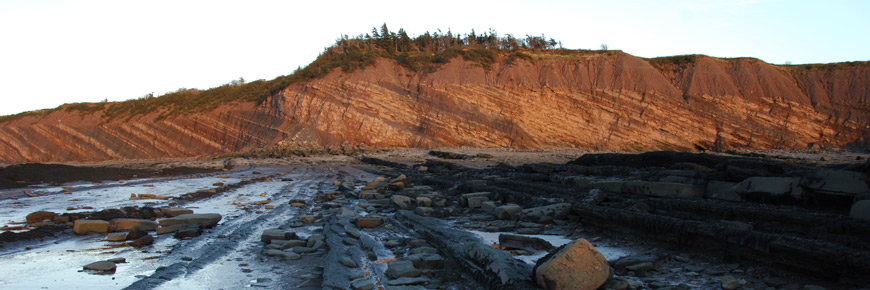
Joggins Fossil Cliffs
Nova Scotia
Date of Inscription: 2008
Approximately 300 million years ago, what is now the eastern shore of Chignecto Bay, on the northern arm of the Bay of Fundy, was a tropical wetland forest located near the equator. Known as the "Coal Age Galapagos," the Joggins Fossil Cliffs provide an outstanding example of the evolution of life on Earth in the Pennsylvanian Period (the “Coal Age”).
Justification of outstanding universal value
Joggins Fossil Cliffs was designated as a World Heritage site by UNESCO’s World Heritage Committee under the following criteria:
Criterion (viii): Earth’s history, geological and geomorphic features and processes: The “grand exposure” of rocks at Joggins Fossil Cliffs contains the best and most complete known fossil record of terrestrial life in the iconic “Coal Age”: the Pennsylvanian (or Carboniferous) period in Earth’s history. The site bears witness to the first reptiles in Earth history, which are the earliest representatives of the amniotes, a group of animals that includes reptiles, dinosaurs, birds, and mammals. Upright fossil trees are preserved at a series of levels in the cliffs together with animal, plant and trace fossils that provide environmental context and enable a complete reconstruction to be made of the extensive fossil forests that dominated land at this time, and are now the source of most of the world’s coal deposits. The property has played a vital role in the development of seminal geological and evolutionary principles, including through the work of Sir Charles Lyell and Charles Darwin, for which the site has been referred to as the “coal age Galápagos”.
Full description
The Joggins Fossil Cliffs reveal the most complete record in the world of terrestrial life in the Pennsylvanian “Coal Age” of Earth history. The site includes the world’s most important fossil record of the two iconic elements of the “Coal Age”: terrestrial tetrapods, including the first reptiles and amniotes; and the “coal swamp” forests in which they lived. The origin of amniotes, the first vertebrates to achieve the capacity to reproduce on land, was one of the most significant events in the history of life on Earth, and this evolutionary milestone is first recorded with certainty in the fossils at Joggins. The cliffs, continually exposed by the world’s highest tides, and the approximately 200 fossilized species of animals and plants found there have long been and continue to be a cornerstone in the development of our understanding of the evolution of life and Earth’s history.
Rich coal deposits drew miners to Joggins from the 17th century on. The Joggins site has been studied by geologists for well over 150 years and discoveries made here have helped shape our understanding of evolution and geology. Sir Charles Lyell, known as the father of modern geology, explored the cliffs at Joggins in 1842 and 1852 with Nova Scotia-born Sir William Dawson, later principal of McGill University. Through them, Joggins found its way into Darwin’s Origin of Species. Abraham Gesner, also Nova Scotia-born, the inventor of coal oil (or kerosene), and Sir William Logan, who established the Geological Survey of Canada, scrutinized the Joggins cliffs as well.
Today the Joggins Fossil Centre, with interpretation of the finest collection of carboniferous fossil specimens in the world and how they shaped our ideas of Earth history and evolution, occupies the site of the old Joggins No. 7 Mine. The cliffs of Joggins are accessible to the public and guided tours of the site are provided.
More Information
Joggins Fossil Cliffs:
World Heritage Centre:
Related links
- Anticosti, Quebec
- Tr’ondëk-Klondike, Yukon
- Writing-on-Stone / Áísínai’pi
- L’Anse aux Meadows National Historic Site
- Nahanni National Park Reserve
- Dinosaur Provincial Park
- Kluane / Wrangell-St.Elias / Glacier Bay /...
- Head-Smashed-In Buffalo Jump
- SG̱ang Gwaay
- Wood Buffalo National Park
- Canadian Rocky Mountain Parks
- Historic District of Old Québec
- Gros Morne National Park
- Old Town Lunenburg
- Waterton-Glacier International Peace Park
- Miguasha National Park
- Rideau Canal
- Landscape of Grand Pré
- Red Bay Basque Whaling Station
- Mistaken Point
- Pimachiowin Aki
- Date modified :